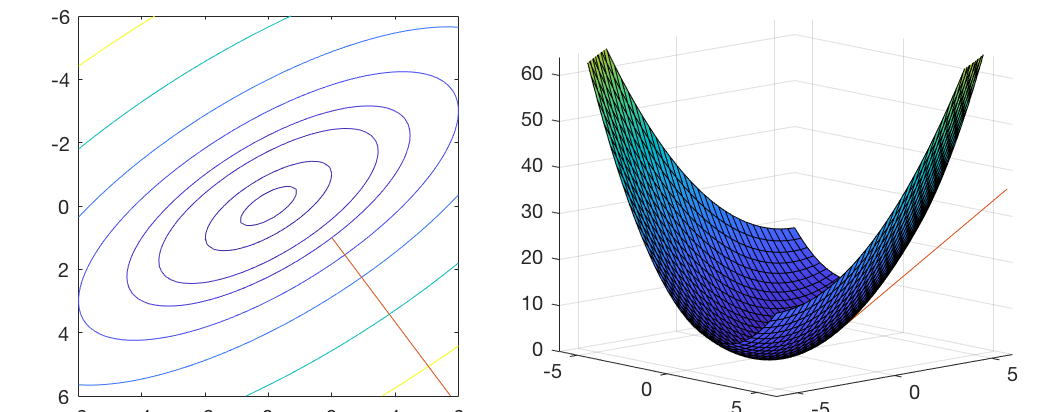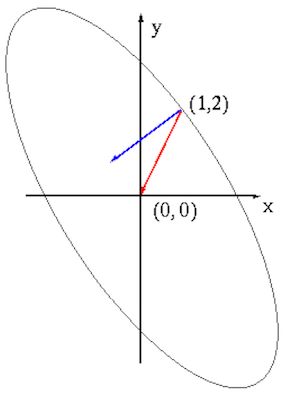Next: Line minimization Up: Unconstrained Optimization Previous: Newton's method
Newton's method discussed above is based on the Hessian





We first consider the minimization of a single-variable function




 where where |
(46) |
 is positive or negative,
the function value
is positive or negative,
the function value  (approximated by the first two terms
of its Taylor series) is always reduced if the positive step size
(approximated by the first two terms
of its Taylor series) is always reduced if the positive step size
 is small enough:
is small enough:
 |
(47) |
 |
(48) |
 at which
at which  and no
further progress can be made, i.e. a local minimum of the function is
obtained.
and no
further progress can be made, i.e. a local minimum of the function is
obtained.
This simple method can be generalized to minimize a multi-variable
objective function





Specifically the gradient descent method (also called steepest
descent or down hill method) carries out the following approximation


 |
(49) |
 and the
minimum of the function
and the
minimum of the function
 is reached.
is reached.
Comparing the gradient descent method with Newton's method we see that
here the Hessian matrix is no longer needed. The iteration simply follows
a search direction





As the gradient descent method relies only on the gradient vector of the objective function without any information contained in the second order derivatives in the Hessian matrix, it does not have as much information as Newton's method and therefore may not be as efficient. For example, when the function is quadratic, as discussed before, Newton's method can find the solution in a single step from any initial guess, but it may take the gradient descent method many steps to reach the solution, because it always follows the negative direction of the local gradient, which typically does not lead to the solution directly. However, for the same reason, the gradient descent method is computationally less expensive as the Hessian matrix is not used.
Example:
Consider a two-variable quadratic function in the following general form:
![$\displaystyle f({\bf x})={\bf x}^T{\bf Ax}+{\bf b}^T{\bf x}+c
=[x_1\;x_2]\left[...
...nd{array}\right]
+[b_1\;b_2]\left[\begin{array}{c}x_1\\ x_2\end{array}\right]+c$](img278.svg) |
 is a symmetric positive semidefinite matrix,
i.e.,
is a symmetric positive semidefinite matrix,
i.e.,
 and
and
 . Specially, if we let
. Specially, if we let
![$\displaystyle {\bf A}=\left[\begin{array}{cc}2 & 1\\ 1 & 1\end{array}\right],\;\;\;\;\;
{\bf b}=\left[\begin{array}{c}0 \\ 0\end{array}\right],\;\;\;\;\; c=0$](img282.svg) |
![$\displaystyle f(x_1,x_2)=\frac{1}{2}[x_1\;x_2]\left[\begin{array}{cc}2&1\\ 1&1\...
...t[\begin{array}{c}x_1\\ x_2\end{array}\right]=\frac{1}{2}(2x_1^2+2x_1x_2+x_2^2)$](img283.svg) |
 at
at  .
.

We assume the initial guess is
![${\bf x}_0=[1,\;2]^T$](img286.svg)
![${\bf g}_0=[4,\;3]^T$](img287.svg)

![$\displaystyle {\bf g}=\left[\begin{array}{c}2x_1+x_2\\ x_1+x_2\end{array}\right...
...ght],\;\;\;\;
{\bf H}^{-1}=\left[\begin{array}{rr}1&-1\\ -1&2\end{array}\right]$](img289.svg) |
![${\bf d}_0=-{\bf H}^{-1}{\bf g}_0=-[1,\;2]^T$](img290.svg) (the red arrow in the figure).
The iteration is:
(the red arrow in the figure).
The iteration is:
![$\displaystyle {\bf x}_1={\bf x}_0-{\bf H}^{-1}{\bf g}_0=\left[\begin{array}{rr}...
...array}{r}4\\ 3\end{array}\right]
=\left[\begin{array}{r}0\\ 0\end{array}\right]$](img291.svg) |
![${\bf d}_0=-{\bf g}_0=-[4,\;3]^T$](img292.svg) , perpendicular to the contour of
the function. The first iteration is:
, perpendicular to the contour of
the function. The first iteration is:
![$\displaystyle {\bf x}_1={\bf x}_0-\delta{\bf g}_0
=\left[\begin{array}{r}1\\ 2\...
...{array}\right]
=\left[\begin{array}{r}1-\delta 4\\ 2-\delta 3\end{array}\right]$](img293.svg) |
 (to be considered later)
to find
(to be considered later)
to find  , and then continue the iteration.
, and then continue the iteration.
The figure below shows the search direction of the Newton's method
(red), which reaches the solution in a single step, based on not only
the gradient 





In the gradient descent method, we also need to determine a proper step
size 



